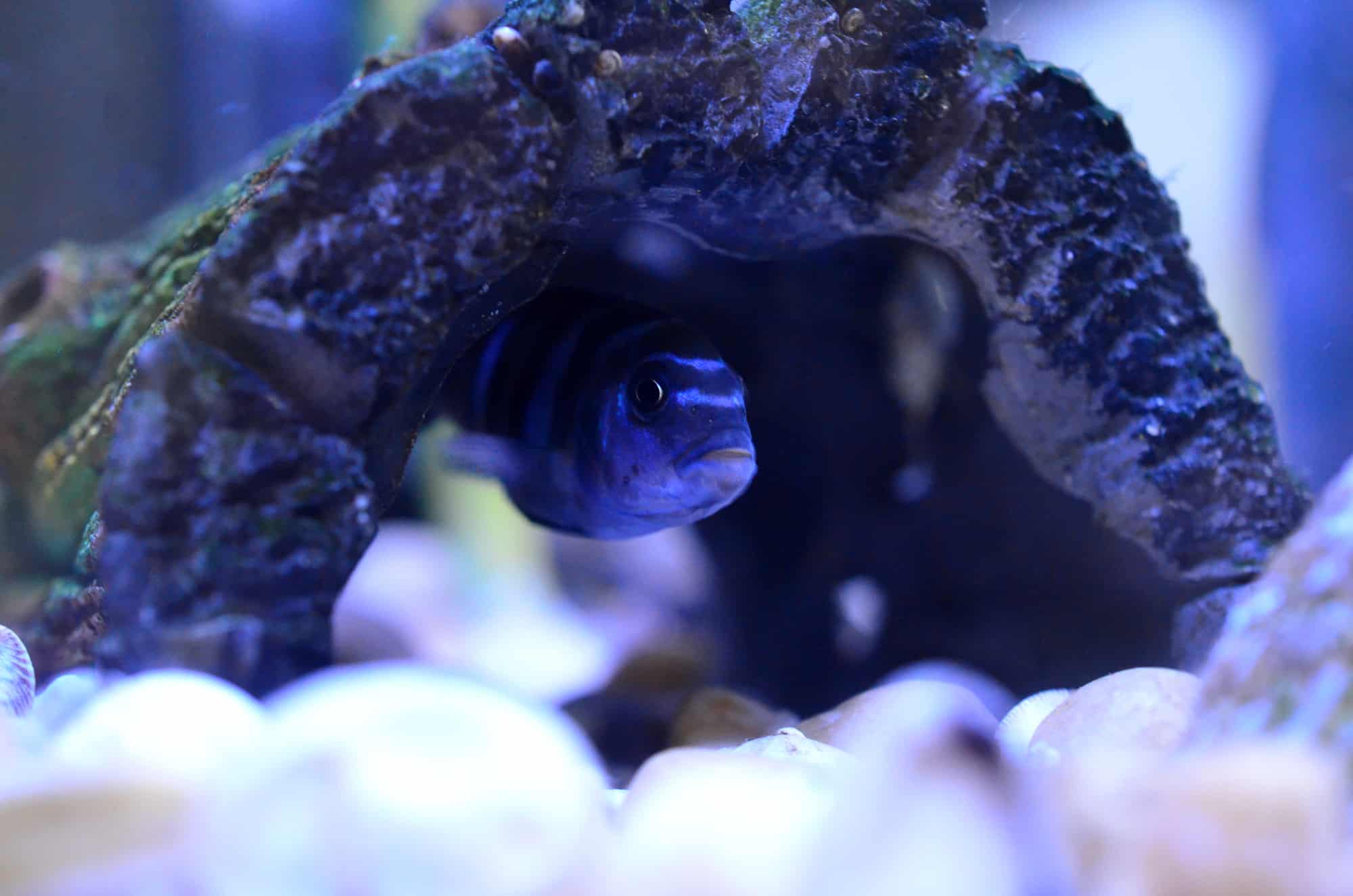Sometimes, you’ll buy a stunning new fish only to find that it hides or sulks for days or even weeks. What is this behavior about, and how should we encourage them to reveal their full glory?
Here we’ll explore the main reasons that your fish may be hiding after being introduced to a new tank, and what you can do to help it find the courage and confidence to make a regular appearance in your aquarium.
Make Sure Your New Fish Is Disease-Free
One of the leading reasons that fish may sulk or hide weeks after being introduced to a new tank is if they’re suffering from a disease or health condition. Sometimes, the cramped, stressful conditions of pet store tanks can produce a breeding ground for fish diseases, meaning your fish will already be infected before it’s even left the store.
Furthermore, traveling from the pet store to your aquarium and acclimating to your tank’s unique conditions can cause considerable stress, resulting in a weakened immune system, and making your fish more susceptible to parasitic, bacterial, and fungal infections.
Because of the increased chances of disease in newly purchased fish, many aquarium owners prefer to keep newbies in a quarantine tank for 2-4 weeks before introducing them to their main aquarium.
If your new fish has reddish gills, unusual spots or markings on its skin, tattered fins, or a swollen abdomen, it may well be suffering from an infection. Refer to a trustworthy aquarium book or look through our health and disease pages to diagnose and treat illnesses as quickly as possible.
Remove Troublesome Tank Mates

One reason that your fish may be hiding is if it’s feeling intimidated. If you have another aggressive fish in the same tank, it’s not uncommon for a newly introduced tank member to be picked on and bullied.
Bullying is especially common where two fish occupy the same habitat niche. A classic example is with bottom-dwelling cichlids such as rainbow cichlids or keyhole cichlids and other bottom-dwelling fish such as cories and plecos. While these cichlids are relatively peaceful towards middle-upper layer fish, other bottom-dwellers may be seen as rivals and turfed out of their caves.
If you suspect that your new fish is hiding away due to intimidation from its tank mates, you can try moving the aggressive fish to another tank. Once the threat has been removed, your new fish may well discover the confidence to swim freely around the tank undisturbed.
Only once your new fish seems established and settled in your tank should you consider reintroducing the troublesome tank mate. At this point, your new fish will hopefully have developed enough confidence to hold their own. If it still doesn’t work out, however, you may be forced to keep the two fish apart for good.
Set the Correct Water Temperature
One reason that a new fish can sulk and hide in a new tank is when the water temperature is less than ideal for their preferences.
I remember in my early days of fishkeeping adding a betta fish to a tank that was set at only 75°F. Since this was a few degrees below the betta’s preferred temperature range of 78-81°F, it never looked happy. It sulked in the corner and sadly didn’t survive long.

While very sad, this experience taught me just how important doing the homework is before buying a new type of fish. Always check with a reliable book or online source the preferred temperature of a fish species before buying.
If you’ve already introduced your fish, however, you may still be able to rescue the situation by adjusting the water temperature on your heater’s thermostat. To avoid thermal shock, do this gradually, by increasing or decreasing temperature by no more than 1-2 degrees each day.
Ensure Proper Water Parameters

In a similar way that inadequate water temperature can prevent a fish from feeling at home, incorrect water parameters can also have a devastating impact on a fish’s well-being.
Each fish species has its own preferences for water hardness and pH. These essential details can be readily retrieved from species careguides in reliable aquarium books and aquarium websites, and must be determined before buying any new fish.
You can easily discover the unique water parameters of your particular tank by using a reliable aquarium test kit. If you’ve already introduced a new fish and the water parameters don’t match up with its preferences, you may still be able to intervene.
By adding pure bicarbonate of soda or limestone powder, you can effectively raise the pH and hardness of your tank’s water. If your hardness and pH are too high, you can reduce it by adding materials that contain tannins such as Indian almond leaves.
As always, be sure to adjust conditions gradually to avoid shocking your fish.
Provide the Right Type of Hiding Places

A slightly counterintuitive tip to help your fish stop hiding away all day is to provide them with even better hiding places!
It’s crucial to understand that different fish species prefer different types of hiding places. While angelfish and tetras enjoy hiding among tall, dense plants. Catfish and loaches prefer hiding in shells and caves.
If your tank only has dense plants but no caves, the bottom-dwellers won’t feel at home and may sulk permanently in a dark corner. Likewise, if your tank contains few plants, fish that prefer that type of habitat may feel out of place and look sad.
By providing the right types of hiding places, your fish will start to feel more comfortable and relaxed and find more courage to swim out in the open once they are well-rested.
Offer Up Some Favorite Foods

One great way to get secretive fish to come out of hiding is to offer them their favorite treats.
While flake foods and fish pellets are useful as staple foods, it’s important to offer your fish a diverse diet that includes items that resemble their native diet. Live and frozen fish foods such as bloodworms, tubifex worms, daphnia, brine shrimp, and mosquito larvae are all nutritious, high-protein foods that most fish go crazy for.
Largely vegetarian fish like silver dollars and severums, on the other hand, may liven up when cooked peas or blanched nettles are added to the tank.
I discovered that even the most secretive fish will usually leap into the spotlight once they smell their favorite treats. If all else fails, be sure to give this a go!
Observe Your Fish at Different Time of Day
One last reason that fish you may not be seeing much of a new fish is that they simply have a reclusive nature, or are primarily nocturnal.
While you may initially feel frustrated not to see more of a fish that’s hiding all day, in my experience, these can become some of the most rewarding species to keep of all.

In my 70-gallon community setup, some of my favorite fish were my upside-down catfish and kuhli loaches. One reason that I loved them so much was how rarely I’d see them!
An occasional glimpse first thing in the morning or at dusk was usually the extent of my encounters with these largely nocturnal species, which offers a clue as to how to enjoy these kinds of fish the most.
If you have fish that seem to hide away for much of the day, try checking out the tank in the morning before you turn the lights on, or in the evening after lights go out.
While you may struggle to witness them as clearly as you would in full light, the shadowy flickers of their activity make them all the more mysterious and alluring. Like me, you may end up coming to love these fish all the more for their elusive character!



